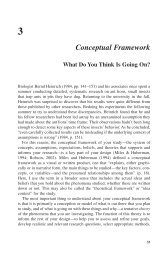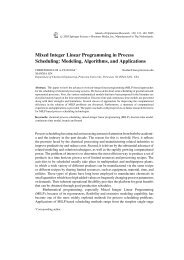Qualitative Research Basics: A Guide for Engineering Educators
Qualitative Research Basics: A Guide for Engineering Educators
Qualitative Research Basics: A Guide for Engineering Educators
Create successful ePaper yourself
Turn your PDF publications into a flip-book with our unique Google optimized e-Paper software.
Determining the size of the sample also relies on intentional researcher choice<br />
as well. Because of both the desire to explore in depth and the labor intensity<br />
of data collection methods, qualitative researchers focus on small instances of<br />
the topic they are exploring. Case studies frequently study only one person or<br />
place or event. Often, researchers identify a tentative number of participants,<br />
documents, or sites they plan to study and as the study unfolds, add or subtract<br />
to this number based on the patterns they are seeing. <strong>Qualitative</strong> researchers<br />
are advised to “sample until redundancy;” that is, until significant new<br />
in<strong>for</strong>mation or details are not appearing and the data are “saturated.” This<br />
requires judgment and will vary according to the purpose and type of study.<br />
Decisions about time in the field are sampling decisions that are as important<br />
as decisions on participant selection. They should be made on the same basis<br />
as other sampling decisions—the researcher should remain on site until data<br />
categories are saturated.<br />
• Mechanisms <strong>for</strong> trustworthiness: In this section of a study plan, qualitative<br />
researchers anticipate what steps they will take to ensure that they have conducted<br />
the study according to criteria <strong>for</strong> quality research. Particular strategies that may<br />
be employed are described in Chapter 5.<br />
• Treatment of ethics: This part of the outline describes how the researcher will<br />
ensure that his or her conduct as a researcher respects the site, the individuals,<br />
and/or the artifacts involved in the study. It also entails other ethical<br />
considerations, such as the responsibility to report data honestly. In the case of<br />
conduct during the study, research with human subjects is governed by federal<br />
laws which are designed to protect research participants from harm. In order to<br />
comply with these laws, all institutions have an Institutional Review Board (IRB)<br />
that reviews research plans. While details vary from institution to institution,<br />
some general guidelines are as follows:<br />
o All research, even studies that use standardized tests, must be reviewed by<br />
the IRB. In some cases, particularly education studies, the research may be<br />
considered “exempt,” meaning the IRB simply needs to be in<strong>for</strong>med of the<br />
study. Other studies may be eligible <strong>for</strong> “expedited review,” which means<br />
that the full IRB does not need to review it, but a designee or smaller<br />
group will do the review. “Full review” by the board is rarely required <strong>for</strong><br />
educational studies, but in cases where minors or sensitive in<strong>for</strong>mation are<br />
involved, it is a possibility.<br />
o All studies require in<strong>for</strong>med consent by the participants. Generally this<br />
means that you will provide a <strong>for</strong>m <strong>for</strong> the participants that describes the<br />
study, what will be done, what benefits they will receive, and what the<br />
potential harms are. At some institutions this <strong>for</strong>m must have an official<br />
approval stamp from the IRB be<strong>for</strong>e it can be used. This <strong>for</strong>m must be<br />
signed by the participants be<strong>for</strong>e data collection begins. The signed copies<br />
must kept on file <strong>for</strong> potential audits. It is also good practice to provide a<br />
second copy to the participants <strong>for</strong> their records.<br />
20
















